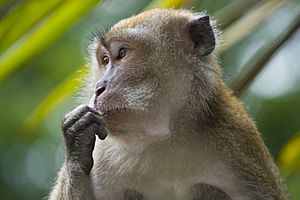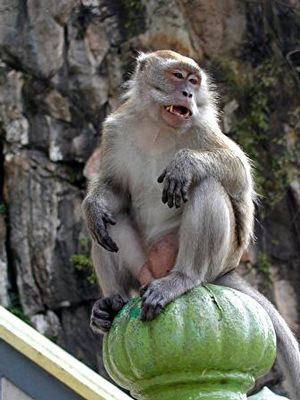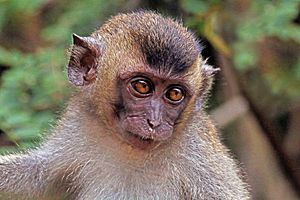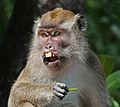Crab-eating Macaque facts for kids
Quick facts for kids Crab-eating macaque |
|
|---|---|
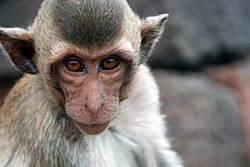 |
|
| Conservation status | |
| Scientific classification | |
| Kingdom: | |
| Phylum: | |
| Class: | |
| Order: | |
| Family: | |
| Genus: | |
| Species: |
M. fascicularis
|
| Binomial name | |
| Macaca fascicularis Raffles, 1821
|
|
The crab-eating macaque (Macaca fascicularis), also known as the long-tailed macaque, is a type of monkey found in Southeast Asia. These monkeys have lived near humans for a very long time. Sometimes people see them as pests that damage crops. Other times, they are seen as sacred animals in temples.
Crab-eating macaques live in social groups led by females. The male monkeys leave their group when they become teenagers. These macaques eat many different kinds of food. They have even been seen using tools to get food. However, crab-eating macaques can also be an invasive species. This means they can harm the natural environment in some places. Because macaques and humans often live in the same areas, the monkeys sometimes lose their natural homes.
Contents
What's in a Name?
The word Macaca comes from a Portuguese word, macaco. This word came from makaku, a word for monkey in the Fiot language from West Africa. The second part of its scientific name, fascicularis, is a Latin word. It means "a small band or stripe." Sir Thomas Raffles gave the monkey this name in 1821. He didn't say exactly why he chose that word.
In countries like Indonesia and Malaysia, these monkeys are often called kera. This name might come from their loud, high-pitched calls.
The crab-eating macaque has a few common names. It's often called the long-tailed macaque because its tail is usually longer than its body. The name "crab-eating macaque" comes from the fact that they are often seen looking for crabs on beaches.
How Do Crab-eating Macaques Look?
Adult crab-eating macaques have bodies that vary in length. They have fairly short arms and legs. Male macaques are much bigger than females. Their tail is longer than their body. They use their tail to help them balance when they jump. The top part of their body is dark brown with light golden brown tips. Their underside is light gray, and their tail is dark gray or brown.
These macaques have hair on their heads that points backward. This hair sometimes forms small crests in the middle. Their skin is black on their feet and ears. However, the skin on their face is a light grayish-pink color. Their eyelids often have clear white markings. Sometimes, they have white spots on their ears. Male macaques have a special mustache and cheek whiskers. Females only have cheek whiskers. Crab-eating macaques also have cheek pouches. They use these pouches to store food while they are looking for more to eat.
How Do Macaques Live in Groups?
Macaques live in social groups. These groups usually have three to 20 females, their young, and one or more males. There are usually fewer males than females in a group. In these groups, the females have a clear ranking system. This means some females are more dominant than others. These ranks usually stay the same throughout a female's life. They can even be passed down through families. Females have the most babies when they are about 10 years old. They stop having babies completely by the age of 24.
What Do Crab-eating Macaques Eat?
Even though they are called "crab-eating macaques," crabs are not their main food. They are omnivores, meaning they eat both plants and animals. Fruits and seeds make up most of their diet, about 60% to 90%. But they also eat leaves, flowers, roots, and tree bark. Sometimes, they hunt small animals like bird chicks, lizards, frogs, and fish. They also eat insects and bird eggs. In Indonesia, these monkeys have become good swimmers and divers. They dive for crabs and other shellfish in mangrove swamps.
Crab-eating macaques can sometimes start to rely on human food. They are known to eat crops in fields, such as young rice, cassava leaves, and coconuts. This can cause big problems for local farmers. In towns and cities, they often find food in garbage cans and trash piles. When they get used to humans, they can become unafraid. This might lead to macaques taking food directly from people, sometimes even aggressively.
Do Macaques Use Tools?
In Thailand and Myanmar, crab-eating macaques use stone tools. They use these stones to open nuts, oysters, and other shellfish. They also open different kinds of sea snails along the coast.
Another example of tool use is how they wash and rub their food. They clean foods like sweet potatoes, cassava roots, and papaya leaves before eating them. Crab-eating macaques either soak these foods in water or rub them with their hands. They also peel sweet potatoes using their front teeth. Young macaques seem to learn these behaviors by watching older monkeys.
Where Do Crab-eating Macaques Live?
The crab-eating macaque lives in many different places. These include lowland rainforests, disturbed forests, and areas with shrubs. They also live near rivers and in coastal forests with nipa palm trees and mangroves. They can easily adapt to living near humans. In some Hindu temples and on small islands, they are considered sacred. However, around farms and villages, they are often seen as pests.
Images for kids
-
A young crab-eating macaque in Ao Nang, Thailand.
-
A crab-eating macaque with a soda can at Bukit Timah, Singapore.
-
Female and young crab-eating macaques at Djuanda Forest Park, West Java, Indonesia.
See also
 In Spanish: Macaco cangrejero para niños
In Spanish: Macaco cangrejero para niños



